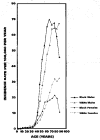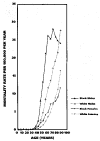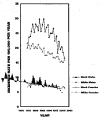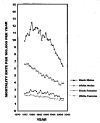Disparities in oral and pharyngeal cancer incidence, mortality and survival among black and white Americans
- PMID: 16521387
- PMCID: PMC1398075
- DOI: 10.14219/jada.archive.2006.0146
Disparities in oral and pharyngeal cancer incidence, mortality and survival among black and white Americans
Erratum in
- J Am Dent Assoc. 2006 Apr;137(4):447
Abstract
Background: The authors present statistics and long-term trends in oral and pharyngeal cancer (OPC) incidence, mortality and survival among U.S. blacks and whites.
Methods: The authors obtained incidence, mortality and five-year relative survival rates via the Surveillance, Epidemiology and End Results (SEER) Program Web site. Current rates and time trends for 1975 through 2002 are presented.
Results: From 1975 through 2002, age-adjusted incidence rates (AAIRs) and mortality rates (AAMRs) were higher among males than among females and highest for black males. By the mid-1980s, incidence and mortality rates were declining for black and white males and females; however, disparities persisted. During the period 1998-2002, AAIRs were more than 20 percent higher for black males compared with white males, while the difference in rates for black and white females was small. AAMRs were 82 percent higher for black males compared with white males, but rates were similar for black and white females. Five-year relative survival rates for patients diagnosed during the period 1995-2001 were higher for whites than for blacks and lowest for black males.
Conclusions: Despite recent declines in OPC incidence and mortality rates, disparities persist. Disparities in survival also exist. Black males bear the brunt of these disparities.
Practice implications: Dentists can aid in reducing OPC incidence and mortality by assisting patients in the prevention and cessation of tobacco use and alcohol abuse. Five-year relative survival may be improved through early detection.
Figures




Comment in
-
Tobacco still is oral health enemy number one.J Am Dent Assoc. 2006 Feb;137(2):144, 146, 148. doi: 10.14219/jada.archive.2006.0126. J Am Dent Assoc. 2006. PMID: 16521375 No abstract available.
References
-
- Jemal A, Murray T, Ward E, et al. Cancer statistics, 2005 (published erratum appears in CA Cancer J Clin 2005;55:259) CA Cancer J Clin. 2005;55:10–30. Erratum in CA Cancer J Clin 2005, 55:259. - PubMed
-
- Silverman S., Jr Demographics and occurrence of oral and pharyngeal cancers: the outcomes, the trends, the challenge. JADA. 2001;132(supplement):7S–11S. - PubMed
-
- Swango PA. Cancers of the oral cavity and pharynx in the United States: an epidemiologic overview. J Public Health Dent. 1996;56:309–18. - PubMed
-
- National Cancer Institute, Surveillance, Epidemiology and End Results (SEER). Overview of the SEER program; 2005. Available at: “www.seer.cancer.gov/about/”. Accessed Dec. 15, 2005.
-
- Fritz A. International classification of diseases for oncology. 3rd ed. Geneva: World Health Organization; 2000.
Publication types
MeSH terms
Grants and funding
LinkOut - more resources
Full Text Sources
Medical

